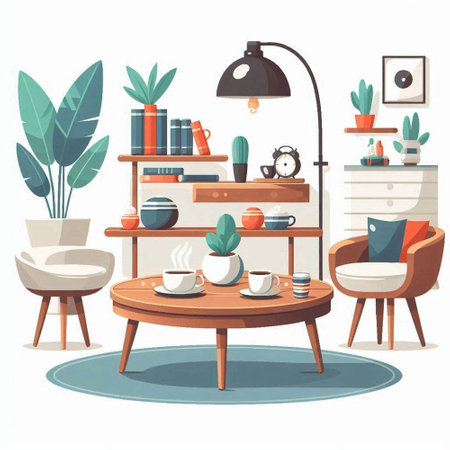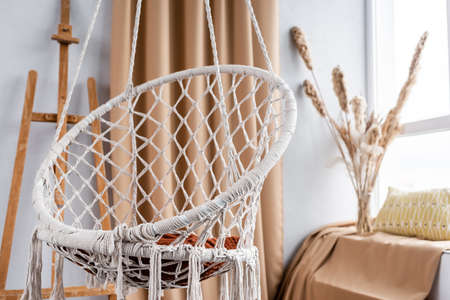Introduction to Natural Materials in Interior Design
In recent years, American homes have experienced a remarkable shift toward the use of natural materials in interior design. This movement is more than just an aesthetic trend—it reflects a broader cultural transformation focused on sustainability and personal wellness. Homeowners and designers alike are increasingly drawn to materials like wood, stone, bamboo, linen, and clay, which not only bring warmth and character to living spaces but also align with eco-friendly values. As people become more conscious of their environmental impact, the appeal of authentic, responsibly sourced materials continues to grow. This cultural shift is driving innovation in the design world, as consumers seek interiors that promote health, comfort, and a connection to nature. In this article, we’ll explore future trends shaping the use of natural materials in American interior design and what homeowners can expect as these influences continue to evolve.
2. Biophilic Design: Bringing the Outdoors In
As natural materials take center stage in future interior design trends, biophilic design is redefining how we experience indoor spaces. Designers across the United States are embracing biophilic principles to create environments that foster a strong connection with nature, ultimately enhancing well-being, creativity, and comfort. This approach goes beyond simply adding houseplants—its about integrating raw textures, organic colors, and living greenery in ways that evoke the outdoors within modern interiors.
Raw Textures and Natural Finishes
Exposed wood grains, stone surfaces, and tactile fabrics are making a big comeback. American designers are moving away from overly processed materials and instead opting for finishes that highlight the imperfections and beauty of nature. For instance, reclaimed wood floors and handwoven textiles offer warmth and authenticity while supporting sustainability. This embrace of texture not only appeals visually but also invites touch, grounding occupants in their surroundings.
Color Palettes Inspired by Nature
Color choices play a key role in biophilic design. Earthy tones—think moss greens, clay reds, sandy beiges, and deep ocean blues—are increasingly popular in both residential and commercial interiors. These hues mimic outdoor landscapes and create soothing atmospheres that help reduce stress and promote relaxation. The table below highlights some of the most common natural color palettes used in contemporary biophilic design:
| Palette | Main Colors | Emotional Effect |
|---|---|---|
| Forest Retreat | Moss green, walnut brown, soft gray | Calm & Grounded |
| Desert Escape | Terracotta, sand beige, ochre yellow | Warm & Inviting |
| Coastal Haven | Navy blue, driftwood tan, seafoam green | Fresh & Restorative |
Plant Integration for Healthier Living Spaces
The integration of living plants is a hallmark of biophilic interiors. From dramatic green walls to subtle potted arrangements on shelves or windowsills, designers are incorporating vegetation to purify air and add dynamic visual interest. In urban environments where access to greenery can be limited, these touches provide a much-needed sense of vitality and connection to the outdoors.
The American Perspective on Biophilia
In the U.S., biophilic design is quickly becoming a standard rather than a luxury—especially as health and wellness continue to influence homebuyers decisions. Workplaces are also adopting this trend to increase productivity and employee satisfaction. As Americans seek refuge from busy lifestyles, expect to see even more emphasis on bringing nature indoors through innovative uses of natural materials and thoughtful plant integration.

3. Innovations in Sustainable Sourcing
The future of natural materials in American interior design is being profoundly shaped by groundbreaking innovations in sustainable sourcing. Across the United States, new technologies and ethical practices are redefining how resources such as wood, stone, and natural fibers make their way from origin to showroom. For instance, smart forestry management systems now use satellite data and AI-driven analytics to ensure that timber is harvested responsibly, reducing deforestation and supporting reforestation efforts. Similarly, advancements in stone quarrying leverage water recycling and precision cutting techniques to minimize waste and environmental impact.
Ethical sourcing has also taken center stage, with a growing emphasis on traceability and fair labor standards. More brands are partnering with local suppliers who follow rigorous certification processes, such as FSC (Forest Stewardship Council) for wood or Fair Trade for textiles. This not only ensures the authenticity of the material but also supports American workers and local economies. Additionally, the use of blockchain technology is becoming increasingly popular for tracking a material’s journey from source to final product, offering transparency that resonates with eco-conscious consumers.
As these innovations become mainstream, homeowners and designers alike can expect greater access to high-quality natural materials that are both beautiful and ethically sourced. The intersection of technology and responsibility is setting a new standard in interior design—one where sustainability isn’t just a trend, but an integral part of every project.
4. Emerging Natural Materials and Applications
As sustainability becomes a core value in interior design, the spotlight is turning to both trending and lesser-known natural materials that are transforming American homes and commercial spaces. Among these, cork, bamboo, and mycelium are gaining traction for their eco-friendly profiles and remarkable versatility. Here’s how these materials are making waves in modern interiors:
Cork: The Quiet Star
Cork is enjoying a renaissance in U.S. design circles due to its renewable nature and unique visual appeal. Harvested from the bark of cork oak trees without harming them, cork offers superior sound absorption and thermal insulation—making it ideal for open-plan living spaces or home offices. Its soft texture and earthy tones fit perfectly with contemporary aesthetics, whether used as wall panels, flooring, or even decorative accents.
Bamboo: Fast-Growing & Functional
Bamboo’s reputation as a fast-growing, highly renewable resource has made it a favorite for eco-conscious designers. It’s not only tougher than many hardwoods but also incredibly adaptable. Bamboo can be crafted into everything from sleek cabinetry to statement lighting fixtures, lending a warm yet modern vibe to interiors. In kitchens and bathrooms, bamboo flooring and countertops offer durability with a light environmental footprint.
Mycelium: Nature’s Innovator
Perhaps the most futuristic of the trio, mycelium—the root network of fungi—is being engineered into building blocks, insulation panels, and even furniture. Mycelium-based products are biodegradable, lightweight, and have impressive fire-resistant qualities. Designers across the United States are experimenting with mycelium to create organic shapes and textures that challenge traditional norms while supporting sustainable practices.
Comparing Emerging Natural Materials
| Material | Key Features | Popular Interior Uses | Sustainability Impact |
|---|---|---|---|
| Cork | Soft, insulating, sound-absorbing | Wall panels, flooring, decor accents | Harvested without tree damage; renewable |
| Bamboo | Strong, fast-growing, versatile | Flooring, cabinetry, furniture | Regenerates quickly; low environmental impact |
| Mycelium | Lightweight, biodegradable, fire-resistant | Insulation panels, furniture, art pieces | Fully compostable; innovative waste reduction |
Pushing Creative Boundaries
The adoption of these emerging natural materials goes beyond just sustainability—they’re expanding what’s possible in American interiors. By leveraging their distinct characteristics and applications, designers can create spaces that feel fresh, responsible, and uniquely personal. As these trends continue to evolve, expect more homes and businesses across the U.S. to feature creative uses of cork, bamboo, mycelium, and beyond.
5. Mixing Old and New: Tradition Meets Technology
One of the most exciting trends in U.S. interior design is the seamless blending of traditional craftsmanship with cutting-edge technology. While American designers have long appreciated the authenticity and timelessness of natural materials like wood, stone, clay, and wool, there is a growing movement to enhance these elements using modern innovations. Today’s artisans often employ time-honored techniques passed down through generations, but they’re also integrating advanced tools such as CNC milling, laser cutting, and digital modeling to elevate their craft. This marriage of old and new not only preserves the unique character of handcrafted items but also ensures precision, durability, and broader creative possibilities.
For example, reclaimed barn wood—a staple in rustic American design—can now be treated with eco-friendly finishes or modified using 3D scanning to fit exact specifications for cabinetry or accent walls. Likewise, handwoven textiles are being produced with sustainably sourced fibers while benefiting from automated looms that maintain consistency without sacrificing artisanal quality. Homeowners can enjoy bespoke pieces that celebrate American heritage while taking advantage of improved performance and customization options thanks to technology.
Ultimately, this synergy between tradition and innovation is redefining what it means to use natural materials in interior spaces across the U.S. It allows designers to honor the past while creating homes that are more functional, sustainable, and visually striking than ever before.
6. The Future Consumer: Eco-Conscious Choices
Across the United States, homeowners are rethinking what truly matters in their living spaces. As environmental awareness continues to grow, so does the desire for interiors that reflect responsible values and sustainable living. Today’s American consumer is more informed than ever, seeking out natural materials that aren’t just beautiful and durable, but also kind to the planet. This shift isn’t just about trends—it’s a lifestyle change, fueled by concerns over climate change, waste reduction, and a healthier home environment.
People are asking tough questions: Where do these materials come from? How long will they last? Are they safe for my family? In response, interior designers and manufacturers are prioritizing transparency, offering products with clear sourcing information and eco-certifications. Homeowners now look for items like FSC-certified wood, recycled glass countertops, organic cotton textiles, and low-VOC finishes—materials that reduce environmental impact while supporting wellness at home.
Another key driver is the desire for longevity. American consumers want their investments to stand the test of time both stylistically and structurally. Natural materials such as stone, bamboo, cork, and reclaimed wood not only offer unique character but also promise durability. By choosing quality over quantity and timeless designs over fleeting fads, homeowners are embracing a “buy less, choose well” philosophy that’s reshaping the future of interior design.
This movement toward eco-conscious interiors isn’t limited to individual homes—it’s influencing larger community developments and urban spaces as well. From energy-efficient multifamily buildings to sustainably sourced furnishings in public venues, American values are shaping a built environment that balances style with stewardship. For those designing or renovating homes in the coming years, understanding this cultural shift will be key to creating spaces that resonate deeply with today’s—and tomorrow’s—consumers.
7. Conclusion: What’s Next for Natural Materials
As we look ahead, natural materials are set to remain at the forefront of interior design trends across the United States. From sustainably sourced woods and rapidly renewable fibers to innovative biophilic elements, these materials offer both aesthetic value and environmental responsibility. American homeowners and designers are increasingly prioritizing eco-friendly choices, not just for their beauty, but for their lasting impact on well-being and sustainability.
Key trends highlight the growing integration of smart technology with natural materials, creating spaces that are both functional and grounded in nature. The resurgence of artisanal craftsmanship and locally sourced elements also signals a shift toward supporting regional economies and reducing carbon footprints. As indoor-outdoor living gains popularity, expect to see more seamless transitions between home interiors and natural landscapes, using stone, clay, bamboo, and reclaimed wood to blur those boundaries.
Looking forward, we predict that the demand for healthy, toxin-free interiors will drive even more innovation in finishes, textiles, and architectural details. Biophilic design principles—bringing the outdoors inside—will continue to shape how Americans think about comfort, productivity, and connection within their homes. Ultimately, natural materials will not only define the look of future spaces but also support a lifestyle that values authenticity, wellness, and environmental stewardship.


